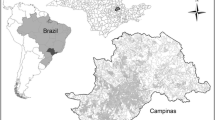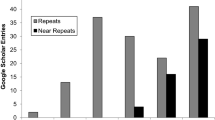Abstract
Research from property crime studies has identified a near-repeat phenomenon, where the risk of repeat burglary victimization is transmitted from a burgled location to nearby locations for a limited amount of time. This article explores the potential for near-repeat patterns to exist in another crime type, specifically the incidence of shootings. Using new tools developed to quantify the spatio-temporal patterns of near-repeats, a study in Philadelphia, U.S.A. finds that there are elevated patterns of near-repeat shootings within 2 weeks and one city block of previous incidents. The elevated risk of a shooting during this period is found to be 33 per cent greater than expected. It is speculated that possible reasons include coercion, retaliation and escalation. Given that the study takes place against the backdrop of a police operation to mitigate retaliatory shootings, the potential for using this information to influence crime prevention policy is discussed.




Similar content being viewed by others
Notes
It should be noted that the expected values for Asian females before and during the Priority Corners program were slightly below the commonly accepted “safe” value of 5.
These totals do not exactly match the totals for Table 1 as the police data did not record the gender of six victims before, and two victims after, the police operation.
The approach we describe here has been pioneered by Johnson, Townsley, Bowers and others building on their earlier work in this area (Townsley et al., 2003; Bowers and Johnson, 2004; Johnson and Bowers, 2004a, 2004b) and to be published in forthcoming research findings as the culmination of collaborative work funded by a British Academy International Collaborative Network award.
References
Anderson, E. (1999) Code of the Street: Decency, Violence, and the Moral Life of the Inner City. New York: W. W. Norton & Company.
Baumer, E. (2002) Neighborhood Disadvantage and Police Notification by Victims of Violence. Criminology. Vol. 40, pp 579–616.
Besag, J. and Diggle, P.J. (1977) Simple Monte Carlo Tests for Spatial Pattern. Applied Statistics. Vol. 26, pp 327–333.
Blumstein, A. (1995) Youth Violence, Guns, and the Illicit-Drug Industry. Journal of Criminal Law and Criminology. Vol. 86, pp 10–36.
Bowers, K.J., Hirschfield, A. and Johnson, S.D. (1998) Victimization Revisited. British Journal of Criminology. Vol. 38, pp 429–452.
Bowers, K.J. and Johnson, S.D. (2004) Who Commits Near Repeats? A Test of the Boost Explanation. Western Criminology Review. Vol. 5, No.3, pp 12–24.
Chainey, S. and Ratcliffe, J.H. (2005) GIS and Crime Mapping. London: John Wiley and Sons.
Courtwright, D. (1996) Violent Land: Single Men and Social Disorder from the Frontier to the Inner City. Cambridge, MA: Harvard University Press.
Diggle, P.J., Chetwynd, A.G. and Haggkvist, R. (1995) Second-Order Analysis of Space–Time Clustering. Statistical Methods in Medical Research. Vol. 4, pp 124–136.
Farrell, G. and Pease, K. (1993) Once Bitten, Twice Bitten: Repeat Victimisation and its Implications for Crime Prevention Police Research Group: Crime Prevention Unit Series Paper 46.
Firman, J.R. (2003) Deconstructing CompStat to clarify its intent. Criminology and Public Policy. Vol. 2, pp 457–460.
Grabosky, P. (1995) Counterproductive Crime Prevention. In Crime Prevention Conference 1994. Brisbane: Centre for Crime Policy and Public Safety, Griffith University, pp 151–165.
Grabosky, P. (1996) Unintended Consequences of Crime Prevention. In Homel, R. (ed.) Crime Prevention Studies. Vol. 5, Monsey, NY: Criminal Justice Press.
Harries, K. (1996) Serious Violence: Patterns of Homicide and Assault in America, 2nd edn.Springfield, IL: Charles Thomas.
Jacobs, B. and Wright, R. (1999) Stick-Up, Street Culture, and Offender Motivation. Criminology. Vol. 37, pp 149–174.
Jacobs, B.A., Topalli, V. and Wright, R. (2000) Managing Retaliation: Drug Robbery and Informal Sanction Threats. Criminology. Vol. 38, pp 171–198.
Johnson, S.D. and Bowers, K.J. (2004a) The Burglary as Clue to the Future: The Beginnings of Prospective Hot-Spotting. European Journal of Criminology. Vol. 1, pp 237–255.
Johnson, S.D. and Bowers, K.J. (2004b) The Stability of Space–Time Clusters of Burglary. British Journal of Criminology. Vol. 44, No. 1, pp 55–65.
Knox, E.G. (1964) Epidemiology of Childhood Leukaemia in Northumberland and Durham. British Journal of Preventive and Social Medicine. Vol. 18, pp 17–24.
Lawton, B.A., Taylor, R.B. and Luongo, A.J. (2005) Police Officers on Drug Corners in Philadelphia, Drug Crime, and Violent Crime: Intended, Diffusion, and Displacement Impacts. Justice Quarterly. Vol. 22, pp 427–451.
Ley, D. (1974) The Black Inner City as Frontier Outpost. Washington, DC: The Association of American Geographers.
Massey, D. and Denton, N. (1993) American Apartheid: Segregation and the Making of the Underclass. Cambridge, MA: Harvard University Press.
McDonald, P.P. (2002) Managing Police Operations: Implementing the New York Crime Control Model – CompStat. Belmont, CA: Wadsworth.
Moore, M.H. (2003) Sizing up CompStat: An Important Administrative Innovation in Policing. Criminology and Public Policy. Vol. 2, pp 469–494.
Moore, M.H. and Braga, A.A. (2003) Measuring and Improving Police Performance: The Lessons of Compstat and its Progeny. Policing: An International Journal of Police Strategies & Management. Vol. 26, pp 439–453.
Mullins, C., Wright, R. and Jacobs, B. (2004) Gender, Streetlife and Criminal Retaliation. Criminology. Vol. 42, pp 911–940.
Nettler, G. (1982) Killing One Another. Cincinnati, OH: Anderson Publishing Co.
Ousey, G. and Augustine, M. (2001) Young Guns: Examining Alternative Explanations of Juvenile Firearm Homicide Rates. Criminology. Vol. 39, pp 933–968.
Polvi, N., Looman, T., Humphries, C. and Pease, K. (1991) The Time Course of Repeat Burglary Victimization. British Journal of Criminology. Vol. 31, pp 411–414.
Rengert, G. (1996) The Geography of Illegal Drugs. Boulder, CO: Westview Press.
Rengert, G., Ratcliffe, J.H. and Chakravorty, S. (2005) Policing Illegal Drug Markets: Geographic Approaches to Crime Reduction. Monsey, NY: Criminal Justice Press.
Sampson, R., Raudenbush, S. and Earls, F. (1997) Neighborhoods and Violent Crime: A Multilevel Study of Collective Efficacy. Science. Vol. 277, pp 918–924.
Siegel, L. (2007) Criminology: Theories, Patterns, and Typologies. Belmont, CA: Thompson Wadsworth.
Sherman, L.W. (1990) Police Crackdowns: Initial and Residual Deterrence. In Tonry, M. and Morris, N. (eds) Crime and Justice: An Annual Review of Research. Vol. 12 Chicago: University of Chicago Press, pp 1–48.
Sherman, L.W., Shaw, J.W. and Rogan, D.P. (1995) The Kansas City Gun Experiment. Washington, DC: National Institute of Justice.
Singer, S. (1986) Victims of Serious Violence and Their Criminal Behavior: Subcultural Theory and Beyond. Violence and Victims. Vol. 1, pp 61–70.
Stewart, E. and Simons, R. (2006) Structure and Culture in African American Adolescent Violence: A Partial Test of the “Code of the Street” Thesis. Justice Quarterly. Vol. 23, pp 1–33.
Townsley, M., Homel, R. and Chaseling, J. (2000) Repeat Burglary Victimisation: Spatial and Temporal Patterns. Australian and New Zealand Journal of Criminology. Vol. 33, pp 37–63.
Townsley, M., Homel, R. and Chaseling, J. (2003) Infectious Burglaries: A Test of the Near Repeat Hypothesis. British Journal of Criminology. Vol. 43, pp 61–633.
Walsh, W.F. (2001) Compstat: An Analysis of an Emerging Police Managerial Paradigm. Policing: An International Journal of Police Strategies & Management. Vol. 24, pp 347–362.
Weiner, N., Zahn, M. and Sagi, R. (1990) Violence: Patterns, Causes, Public Policy. NY: Harcourt Brace Jovanovich Publishers.
Acknowledgements
We thank Deputy Commissioner Patricia Giorgio-Fox of the Philadelphia Police Department for generous provision of the data and comments on an earlier draft of this paper, and Tony Luongo for his assistance with geocoding. This research was funded by a British Academy International Collaborative Network award and from the Research Incentive Fund and the Institute of Public Affairs at Temple University. The views expressed herein are those of the authors and do not necessarily reflect the views of the Philadelphia Police Department.
Author information
Authors and Affiliations
Corresponding author
Rights and permissions
About this article
Cite this article
Ratcliffe, J., Rengert, G. Near-Repeat Patterns in Philadelphia Shootings. Secur J 21, 58–76 (2008). https://doi.org/10.1057/palgrave.sj.8350068
Published:
Issue Date:
DOI: https://doi.org/10.1057/palgrave.sj.8350068




